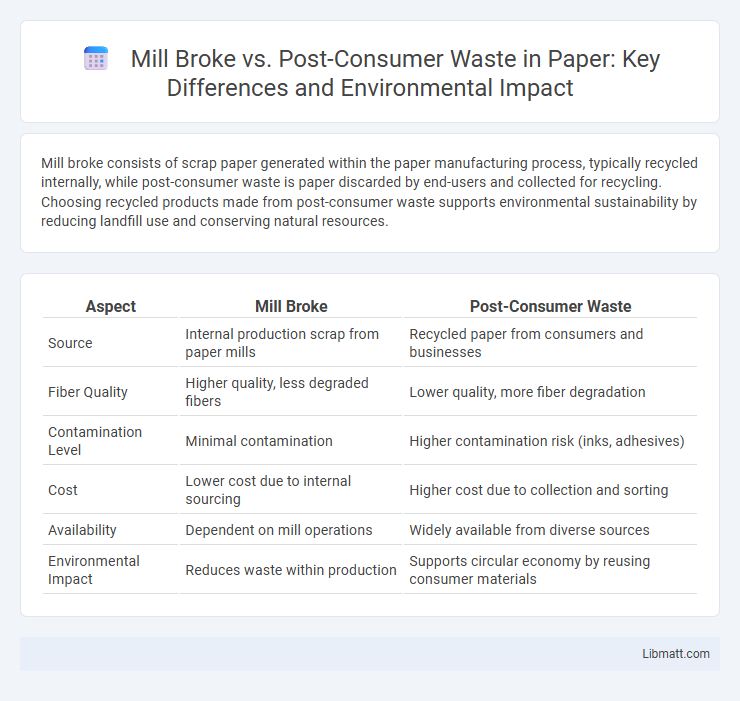Mill broke consists of scrap paper generated within the paper manufacturing process, typically recycled internally, while post-consumer waste is paper discarded by end-users and collected for recycling. Choosing recycled products made from post-consumer waste supports environmental sustainability by reducing landfill use and conserving natural resources.
Table of Comparison
| Aspect | Mill Broke | Post-Consumer Waste |
|---|---|---|
| Source | Internal production scrap from paper mills | Recycled paper from consumers and businesses |
| Fiber Quality | Higher quality, less degraded fibers | Lower quality, more fiber degradation |
| Contamination Level | Minimal contamination | Higher contamination risk (inks, adhesives) |
| Cost | Lower cost due to internal sourcing | Higher cost due to collection and sorting |
| Availability | Dependent on mill operations | Widely available from diverse sources |
| Environmental Impact | Reduces waste within production | Supports circular economy by reusing consumer materials |
Introduction to Paper Recycling
Mill broke refers to the scrap paper generated during the manufacturing process, which is recycled directly within the mill to reduce raw material consumption. Post-consumer waste consists of paper products discarded by consumers after use, requiring collection, sorting, and reprocessing before reintegration into the paper production cycle. Efficient recycling of both mill broke and post-consumer waste minimizes environmental impact and supports sustainable paper production.
Defining Mill Broke
Mill broke refers to the scrap or waste material generated during the paper manufacturing process before the product reaches consumers, often recycled internally to improve efficiency. Unlike post-consumer waste, which comes from used paper discarded by consumers after use, mill broke consists of production off-cuts, trimmings, and defective sheets collected within the mill. Understanding mill broke helps you optimize resource use and reduce raw material inputs in paper production.
Understanding Post-Consumer Waste
Post-consumer waste refers to materials discarded by consumers after they have fulfilled their intended use, making it crucial for sustainable recycling processes. Unlike mill broke, which consists of pre-consumer scrap generated during manufacturing, post-consumer waste directly impacts the circular economy by reducing landfill dependence. Your efforts to prioritize post-consumer waste recycling enhance resource conservation and promote environmentally responsible production.
Key Differences Between Mill Broke and Post-Consumer Waste
Mill broke consists of paper trimmings and rejected materials generated during the manufacturing process, primarily composed of uncontaminated fibers that are easier to recycle. Post-consumer waste refers to paper products discarded after consumer use, containing a mix of fibers and contaminants that require more intensive sorting and processing. The key differences lie in their origin, fiber quality, and contamination levels, with mill broke offering higher purity and efficiency in recycling compared to the more variable and challenging post-consumer waste.
Sources of Mill Broke in Paper Manufacturing
Mill broke in paper manufacturing originates primarily from production scrap such as trimmings, misprints, and paper cuttings generated during the paper conversion process. These scraps are collected directly from the paper machine, rewinding, and cutting stations before reaching the final product stage. Utilizing mill broke helps optimize fiber use and reduce raw material costs while enhancing your paper recycling efficiency.
The Lifecycle of Post-Consumer Waste
Post-consumer waste undergoes a comprehensive lifecycle starting with consumer use, collection for recycling, and processing into reusable materials, reducing landfill burdens and conserving natural resources. Mill broke consists of paper scraps generated during manufacturing, which are recycled internally within mills to enhance sustainability and minimize raw material consumption. Efficient recycling of both post-consumer waste and mill broke contributes significantly to the paper industry's circular economy by lowering energy use and carbon emissions.
Environmental Impact: Mill Broke vs. Post-Consumer Waste
Mill broke, consisting of scrap generated during the paper manufacturing process, is easier to recycle and typically consumes less energy and fewer resources compared to post-consumer waste, which includes used paper discarded by consumers. Recycling mill broke reduces environmental impact by minimizing the need for virgin pulp and lowering greenhouse gas emissions, while processing post-consumer waste involves additional steps like sorting and deinking that can increase energy consumption and pollutant production. Your choice to support products containing mill broke can promote more efficient recycling practices with a smaller ecological footprint.
Role in Sustainable Paper Production
Mill broke plays a crucial role in sustainable paper production by allowing manufacturers to recycle scrap generated during the paper-making process, reducing the demand for virgin fibers and minimizing waste. Post-consumer waste, on the other hand, consists of paper products that have completed their initial use cycle and are collected for recycling, significantly lowering environmental impact by diverting materials from landfills. Incorporating both mill broke and post-consumer waste into production helps your business achieve a circular paper economy, optimizing resource efficiency and promoting eco-friendly practices.
Challenges in Recycling Mill Broke and Post-Consumer Waste
Recycling mill broke faces challenges such as contamination from paper coatings and variability in fiber quality, which complicates processing and reduces output consistency. Post-consumer waste presents greater difficulties due to mixed materials, ink residues, and non-paper contaminants that hinder pulping and recycling efficiency. Managing these challenges effectively improves Your facility's ability to produce high-quality recycled paper products while minimizing environmental impact.
Future Trends in Paper Recycling and Waste Management
Mill broke recycling involves reclaiming waste generated during paper manufacturing, which offers a more controlled and higher-quality input for paper production compared to post-consumer waste that requires extensive sorting and decontamination. Future trends in paper recycling emphasize advanced technologies such as AI-driven sorting systems and chemical recycling to improve the efficiency and purity of recycled fibers from both mill broke and post-consumer sources. Your sustainability efforts can benefit significantly by integrating these innovations, reducing environmental impact while enhancing the circular economy in paper waste management.
Mill broke vs post-consumer waste Infographic

 libmatt.com
libmatt.com